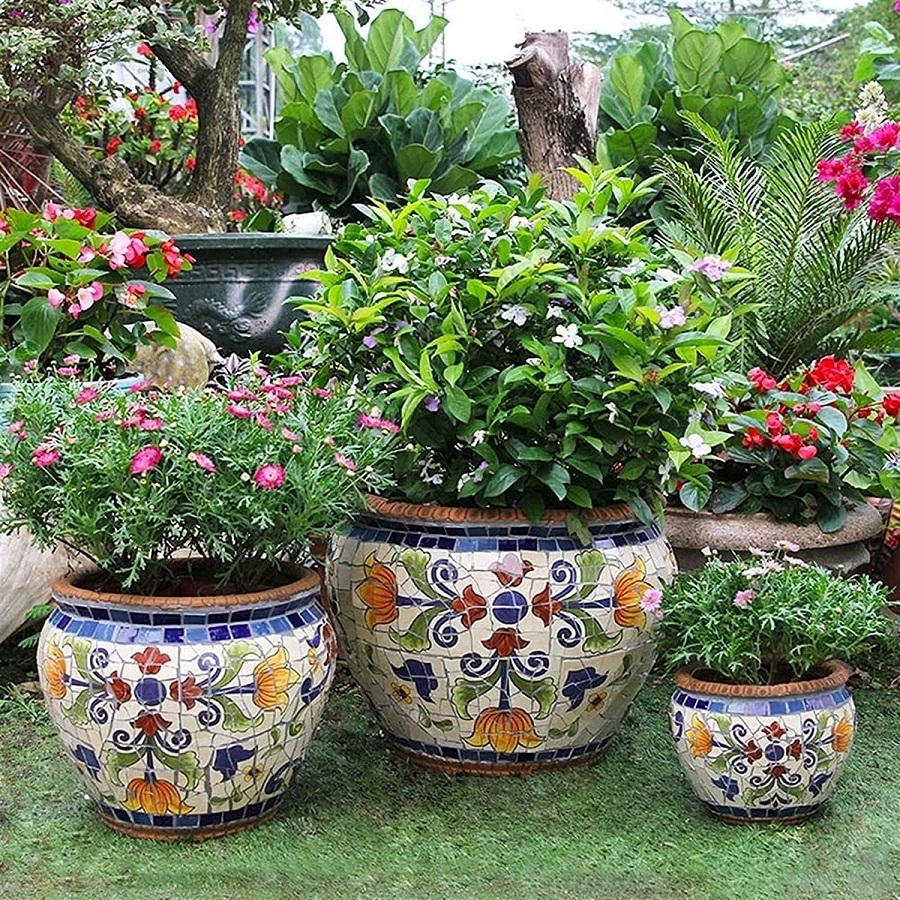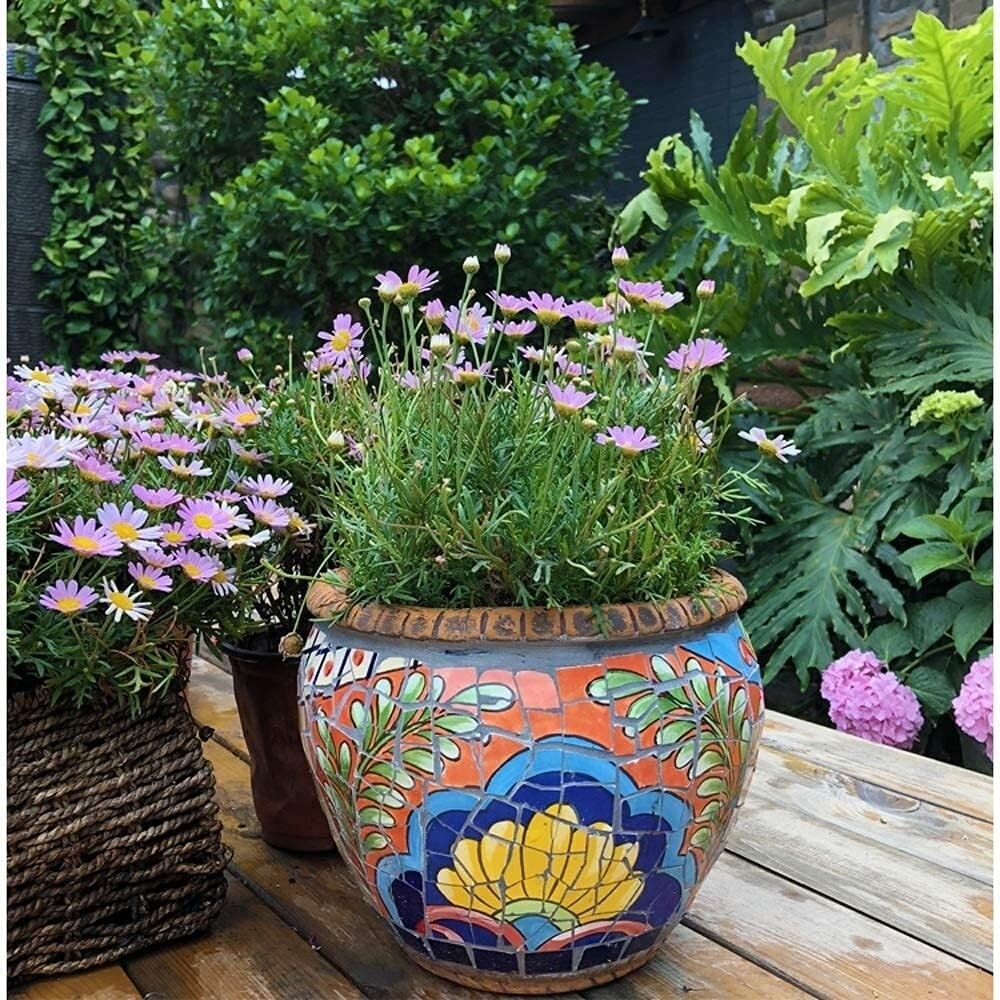Selecting the Right Flower Pots for Your Landscape
Choosing the right flower pots is key for successful landscaping with flower pots. Not all pots are equal in terms of durability, aesthetics, and functionality. Here’s how to select the best ones for your garden:
- Material Matters: Flower pots come in various materials, including terracotta, ceramic, plastic, and metal. Each has its pros and cons. Terracotta is porous and great for drainage but can break in cold weather. Plastic pots are lightweight and cost-effective but may not last as long.
- Size and Scale: The pot size should match the plant’s growth potential. Large plants need deep pots for root development. Smaller pots suit herbs and annuals. Remember, the pot size can affect watering frequency.
- Drainage is Crucial: Good drainage prevents root rot. Ensure pots have holes at the bottom. If not, be ready to drill some yourself. Trays can help catch excess water but don’t let pots sit in standing water.
- Style and Color: Choose pots that complement your home’s style and color palette. Bold colors can add accents, while earth tones blend with natural surroundings. Think about how the pot’s shape and texture fit into the overall landscape design.
Matching the right pots with your landscape enhances growth and adds curb appeal. Keep these tips in mind when shopping for flower pots to ensure your garden thrives.

Design Principles for Arranging Flower Pots
When you’re landscaping with flower pots, arrangement is key to creating an eye-catching garden. Here are some design principles to follow:
- Balance Your Space: Arrange pots to create symmetry or an informal look. Use similar sizes or colors to achieve balance.
- Vary the Heights: Mix different pot heights to draw the eye up and down. This adds depth to your garden.
- Consider Texture: Different materials can introduce varied textures. Combine them to enhance visual appeal.
- Play With Colors: Coordinate flower and pot colors to complement or contrast with each other. This can set a mood or theme in your garden.
- Cluster for Impact: Grouping pots together can create a focal point. Odd numbers of pots often look best in groupings.
- Leave Space: Don’t crowd your pots. Give each one some space to shine and allow for growth.
- Keep Them Accessible: Place pots so plants get the right amount of sun and you can easily water them.
Adhere to these principles, and your potted landscape will not only flourish but also look thoughtfully designed.
Seasonal Considerations for Potted Plants
When planning your landscaping with flower pots, seasonality plays a pivotal role. Potted plants are exposed to weather changes, so choosing the right plants for the right season is crucial. Here’s how to navigate through the seasons:
- Spring Selections: Opt for frost-resistant plants as nights can still be chilly. Pansies and primroses are great for adding color early in the year.
- Summer Sun-lovers: Geraniums and petunias love the heat and are perfect for sunny spots. Remember to water them more often during hot spells.
- Autumn Adjustments: As temperatures drop, switch to hardy mums and ornamental kale. They offer beautiful colors and last well into the cooler months.
- Winterizing: In colder regions, bring sensitive plants indoors or choose evergreens that can withstand the frost. Protect pots with insulation like burlap wraps.
- Rotating Plants: Keep your garden vibrant by rotating plants according to their blooming cycles. This ensures something is always flowering.
- Mulching Matters: Apply a thick layer of mulch in the pots to conserve moisture and protect roots from temperature extremes.
Adjusting your flower pot choices as seasons change will keep your garden lively all year round. With these seasonal tips, your potted plants will flourish, enhancing your landscape’s charm with continuous growth and blooms.
Incorporating Flower Pots into Different Landscape Styles
Integrating flower pots into various landscape styles can dramatically enhance the visual appeal of your outdoor space. Whether your home features a modern, traditional, or eclectic style, there are ways to make flower pots a complementing element. Here’s a breakdown of how to incorporate them into different styles:
- Modern Landscapes: In modern settings, choose sleek, geometric pots. Materials like concrete or metal work well. Opt for monochrome colors or metallic finishes to keep things minimalist and elegant.
- Traditional Gardens: For a timeless look, select classic terracotta or ceramic pots. Ornate designs and warm colors reflect a traditional aesthetic. Position them symmetrically for a balanced appearance.
- Cottage Style: Embrace a more whimsical approach with mixed sizes and colors of flower pots. Clustering pots adds a charming and cozy feel typical of cottage gardens.
- Tropical Themes: Large, bright-colored pots suit tropical landscapes. Consider using large pots with exotic plants to create a bold impact.
- Desert Landscapes: Use stone or terracotta pots to complement the natural desert scenery. Plants like cacti and succulents in these pots will enhance the arid landscape style.
In each case, ensure the plants you select are suitable for the climate and the pot’s material. Arranging pots thoughtfully according to the landscape style can create harmony and enhance the overall aesthetic of your garden.

Maintenance Tips for Landscaped Flower Pots
Consistent upkeep is key in making your potted garden look its best. Let’s look at some helpful maintenance tips for your landscaped flower pots that will aid in their longevity and beauty:
- Regular Watering: Check soil moisture often. Potted plants dry out faster than those in the ground.
- Fertilizing: Feed your plants. Use a balanced, slow-release fertilizer to promote growth.
- Pruning and Deadheading: Remove dead flowers and leaves. This encourages new growth and keeps plants healthy.
- Cleaning Pots: Wipe down pots to prevent algae and pests. Clean pots mean healthier plants.
- Checking for Pests: Inspect plants regularly. Deal with pests quickly to avoid infestations.
- Repotting When Needed: Change pots when plants outgrow them. This gives roots more space to expand.
- Seasonal Care: Adjust care as seasons change. Protect pots from extreme cold and heat.
By following these tips, your flower pots will remain an alluring feature in your landscaping throughout the year. Remember, a little attention goes a long way in keeping your potted garden thriving and vibrant.
Scaling Your Design: From Small Spaces to Larger Gardens
When you start landscaping with flower pots, you begin to appreciate their versatility. Whether you’re working with a compact balcony or a sprawling backyard, flower pots can play a significant role. Here are some tips for scaling your design from small spaces to larger gardens.
- Begin with a Plan: Measure your space. Decide on a focal point. Sketch a layout.
- Choose Appropriate Sizes: In smaller areas, use smaller pots to avoid clutter. In larger spaces, mix big and small pots for variety.
- Create Zones: Define areas for dining, lounging, or gardening. Use pots to mark these zones.
- Use Vertical Space: Add shelves or hanging pots in small areas. This saves floor space for other items.
- Maintain Proportion: Keep pot size in harmony with plant size. This ensures a balanced look.
- Add Layers: Stack pots or use tiered planters for depth. This technique works well in any garden size.
- Repetition Is Key: Repeat colors and shapes to unify your space. This creates a sense of order.
- Exploit Texture and Color: In larger gardens, bold colors draw the eye. Textured pots add interest.
- Mobile Pots for Flexibility: Wheels on large pots make them easy to move. This is helpful for changing layouts.
By applying these scalable techniques, you can create a garden that’s adaptable to any size. Flower pots offer the perfect opportunity to expand your gardening horizons, no matter the scope of your outdoor space.
DIY Landscaping Projects with Flower Pots
DIY landscaping with flower pots is a popular way to add personal flair to outdoor spaces. Here are some fun and practical projects:
- Create a Herb Garden: Select small to medium-sized pots for growing herbs. Place them near your kitchen for easy access while cooking.
- Make a Succulent Arrangement: Group different sizes of pots with various succulents. Their low maintenance makes them perfect for busy gardeners.
- Build a Pot Fountain: Use larger pots to create a water feature. It’s a relaxing addition to any garden and can be a central point.
- Craft a Pot Trellis: Attach a trellis to a large pot. Grow climbing plants like ivy or roses for a vertical accent.
- Design a Miniature Garden: Get creative with tiny pots. Construct a fairy garden for a magical touch.
- Develop a Potted Pathway: Line a walkway with pots filled with flowers or grasses. This leads visitors through your garden.
- Plant a Butterfly Garden: Choose pots that can host butterfly-friendly plants. Attract these beautiful insects to your space.
Each project can reflect your style and add character to your garden. With a little effort, pots become an integral part of your landscaping design.

Leveraging Flower Pots for Eco-Friendly Landscaping
Landscaping with flower pots isn’t just about beauty. It can be eco-friendly too. Here’s how to use pots to create a green garden:
- Choose Sustainable Materials: Select pots made from recycled or biodegradable materials. This reduces waste and helps the environment.
- Save Water with Self-Watering Pots: These pots have a reservoir. They use water efficiently and cut down on waste.
- Go Organic: Use organic soil and fertilizers. This keeps your plants and the environment healthy.
- Promote Biodiversity: Plant native species in your pots. They attract local wildlife and support ecosystems.
- Reuse and Repurpose: Don’t throw away old pots. Find new ways to use them or give them a fresh coat of paint.
- Compost: Create compost in one of your larger pots. Use kitchen scraps and yard waste to feed your plants.
- Collect Rainwater: Use a rain barrel to water your pots. This conserves tap water and is better for plants.
- Grow Your Food: Use pots to grow vegetables and herbs. This cuts down on grocery shopping and packaging waste.
By adopting eco-friendly practices, your flower pots can contribute to a sustainable lifestyle. Plus, you’ll have a thriving, eco-conscious garden to enjoy.
